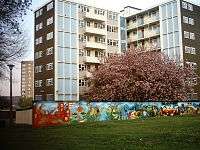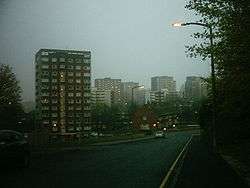Little London, Leeds
Coordinates: 53°48′27″N 1°32′26″W / 53.8075°N 1.5406°W
Little London, along with its adjacent areas Lovell Park and Blenheim, is an area of 1960s high-rise and maisonette council housing in inner-city north Leeds, West Yorkshire, England, situated between the city centre and Sheepscar. The area falls within the Hyde Park and Woodhouse ward of the City of Leeds Council.
Community
Amenities
The area backs onto the Sheepscar Interchange, a major road interchange between the A61 towards Harrogate and the A58 towards Wetherby) and the Leeds Inner Ring Road. The Merrion Centre is also nearby. It has a small shopping precinct with an Off Licence and various other shops, and a new children's centre, the Little London Children's Centre, designed by Leeds architects Bauman Lyons. The area's most notable public house, The Londoner (formerly The Little Londoner) closed in 2005 and was demolished in 2006; there is now a building exceeding 20 stories on the site of the former pub. This now leaves just two pubs, The Hobby Horse (Now closed) and The Leeds Rifleman. The Post Office closed in August 2008, despite a public campaign to save it.
Housing
Council housing in the lower parts of Little London originally homed many of the people from nearby Woodhouse, where there was large scale demolition and slum clearance. Originally, Woodhouse residents were to be dispersed around Leeds but, after a protracted battle with the council, they won the right to move a short distance to the new Holborn Estate.
In 2006 there were plans to demolish or sell 450 largely 1960s and 1980s council built housing units in Little London, under an £85m redevelopment and refurbishment scheme. This would have left only the high rise flats which would be privatised and sold. There were fears that more than 600 homes could be lost and the cohesion of the community affected.[1]
The three Lovell tower blocks were saved from demolition to undergo refurbishment, with a plan to build 125 new local authority homes, this, with local environment and amenity improvements, to be carried out under a 2008 Private Finance Initiative. The local tenants and residents association expressed concern that the demolition or sale of the housing stock would could lead to the loss of 300 council homes, and hundreds of residents having to leave the area permanently.[2] A campaign and debate with Leeds City Council is ongoing.
Depopulation

Over the past few years Leeds City Council has begun to move residents out of homes. Two blocks of Carlton Towers are now uninhabited, as are several smaller blocks of flats; Lovell Park hasn't, as yet, been affected, and is noticeably the least run-down area of Little London, perhaps because of an increase in population following the building of high-rise student accommodation on Lovell Park Road. The number of students there is not as large as found in Headingley, Woodhouse, or Hyde Park.
Lower population has not affected many businesses, with only the bookmakers having closed recently. With a lower population, many on-street car parking spaces have been freed, some of which are being used by those visiting and working in Leeds city centre.
Crime
In the early 2000s ASBOs had been issued in the Little London area to counter drug dealing and anti-social behaviour. The leader of the Labour Party Group on Leeds Council thought that these orders had been achieving a reduction in crime in the area. In 2003 66 ASBOs were issued in Little London as a “crackdown” on anti-social behaviour and drug dealing, the area of Blackman Lane identified as a centre for supply of controlled drugs and attendant criminality. The tenants and residents association, along with politicians, expressed support for the police action, which was assured would continue.[3] In a letter to the Yorkshire Evening Post in 2004, he expressed the view that support for ASBOs by the Council needed to be sustained as residents in Little London had noticed a then recent increase in drug dealing, and he hoped that the council would continue to commit funding and commitment to the problem.[4]
In November 2011 Little London became a target for street robberies, sometimes accompanied with violence, over Bonfire Night weekend and later in the month[5][6]

Notable people
- Will Scott (1893−1964), author born at 128 Camp Road (now demolished and renamed Oatland Lane)
- Frank Percy Wild, (1861–1950), artist,was born at 50 Camp Road
References
- ↑ "Facelift: Tenants to quiz council"; Yorkshire Evening Post, 31 January 2006. Retrieved 29 April 2012
- ↑ "An 85m revamp tenants: 'Hands off our homes'"; Yorkshire Evening Post, 31 January 2006. Retrieved 29 April 2012
- ↑ "Drug Blitz"; Yorkshire Evening Post, 9 September 2003. Retrieved 29 April 2012
- ↑ “Asbos are working”; Letters to the editor. Yorkshire Evening Post, 1 August 2004. Retrieved 29 April 2012
- ↑ Mulholland, Greg; "Extra police patrols after spate of street attacks hit students in Leeds"; The Guardian, 25 November 2011. Retrieved 29 April 2012
- ↑ "Leeds Police investigate series of violent robberies", Harrowgate News, 15 November 2011. Retrieved 29 April 2012
External links
![]() Media related to Little London, Leeds at Wikimedia Commons
Media related to Little London, Leeds at Wikimedia Commons
 |
Potternewton |  | ||
| Woodhouse | |
Sheepscar | ||
| ||||
| | ||||
| Leeds city centre |

